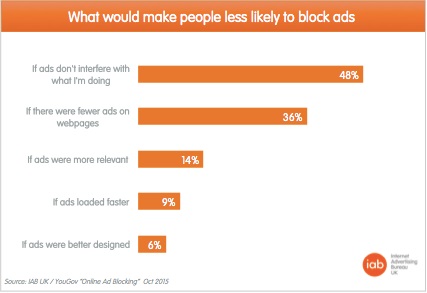Nearly one fifth (18%) of British adults online are currently using ad blocking software, signalling a rise from 15% in early June, according to new data.

The latest wave of the Internet Advertising Bureau UK’s Ad Blocking Report, conducted online by YouGov, reveals that Ad blocking is more prevalent among men surveyed (23%) than women (13%) and the propensity to block ads decreases with age – from 35% of 18-24 year olds to 13% of people 55+.
Key findings:
· Small rise from 15% to 18%, propensity to block decreases with age
· 40%’s main motivation isn’t to block all ads
· Less interference and fewer ads are main ways to stem ad blocking
40%’s main motivation isn’t to block all ads
However, less than six in 10 (57%) people who’ve ever downloaded the software said their main motivation was to block all ads; 20% said the main reason was to block certain types of ads or ads from certain websites.
Less interference and fewer ads main ways to stop ad blocking
The most common reason people would be less likely to block ads is if they didn’t interfere with what they were doing (cited by 48%) followed by having fewer ads on a page (36%). One in seven (14%) would be less likely to block ads if they were more relevant.
“The small rise in people blocking ads is not unexpected considering the publicity it’s been receiving,” said IAB UK’s CEO, Guy Phillipson. “However, it does provide some perspective on the situation for those referring to an “adblockalypse.” More importantly, it also provides a clear message to the industry – a less invasive, lighter ad experience is absolutely vital to address the main cause of ad blocking. That’s why we’re developing the L.E.A.N advertising principles for the online advertising supply chain.”
Majority still prefer free content and ads vs having to pay
When told that ad blocking means some websites will have to stop providing free content or charge people to use them, 61% of British adults online said they would prefer to access content for free and see ads than pay to access content.
Phillipson explains: “The other key tactic to reduce ad blocking is making consumers more aware of the consequences – what we call the “value exchange.” If more people realise content is only free because ads pay for it, then fewer people will be inclined to block ads. Only 4% are willing to face the other option – paying for content with no ads.”
Among those currently using ad blocking software, 71% are doing so on laptops, 47% on desktop PCs. Less than one in five (19%) are blocking ads on tablets and just under a quarter (23%) on mobiles.
Methodology
YouGov’s total sample size was 2,052 adults. The survey was conducted online during 22-23rd October 2015. The figures have been weighted and are representative of all GB adults (aged 18+). The previous wave was conducted 9-10th June 2015, with a sample size of 2,057. The percentage of current ad blockers figure is calculated by asking if they have ever downloaded software on any of their personal devices that allows them to block adverts on the internet followed by a question to ascertain if they are a current user.
